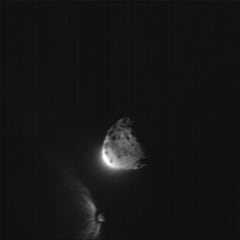‘Planet killer’ asteroid detected: Could it hit the Earth? When?
It may conjure images of sci-fi thrillers, but 2022 AP7 is highly unlikely to pose a threat to the planet in the near future.


Astronomers say they have discovered the biggest ‘planet-killer’ asteroid identified in eight years and current projections suggest that it will cross the earth’s orbit in future.
However the asteroid - 2022 AP7 - is not on a collision course with our planet and will likely cross the solar system while the Earth is on the far side of the moon.
Officially classed as a Potentially Hazardous Asteroid (PHA) the huge asteroid is thought to be around one mile wide, placing it in the top 5% of the largest PHAs ever discovered. Scott Sheppard, lead author of the study in Astronomical Journal, said it was one of three “rather large” asteroids identified.
“Any asteroid over 1km in size is considered a planet killer,” said Sheppard, when asked about the potential consequences of a collision.
“The Earth’s surface would likely cool significantly from sunlight not getting to the planet. It would be a mass extinction event like hasn’t been seen on Earth in millions of years.”
With a diameter between 1.1km and 2.3km, asteroid 2022 AP7 is the largest potentially hazardous asteroid found since 2014 ☄️
— The Conversation (@ConversationEDU) November 2, 2022
What makes a planet killer?@stingay from @CurtinUni explains:https://t.co/e7gc671OYc
Over time, Sheppard said, the asteroid’s trajectory is expected to bring it closer to the Earth’s orbit, but that process would take so long that it is impossible for scientists to predict with any accuracy.
Sheppard added: “This will be centuries into the future and we do not know the orbit of 2022 AP7 precise enough to say much about its dangers centuries from now.”
Success of NASA’s Dart mission provides additional protection
While the asteroids identified recently pose no real threat to Earth, scientists continue to test for the possibility of a potential impact in future.
Last month NASA confirmed that its Dart mission had successfully altered the orbit of a 520ft-wide asteroid called Dimorphos. The space rock did not pose any threat to the planet but it offered the first chance for the space agency to test out the program’s capabilities.
The mission successfully flew a spacecraft into the asteroid in a bid to change its direction. Controllers at the Johns Hopkins University Applied Physics Laboratory calculated that the craft made contact just 17m from the exact centre of Dimorphos, showing how accurate the technology was in its first real outing.
Related stories
Dr Lori Glaze, NASA’s director of planetary science, said: “We’re embarking on a new era of humankind, an era in which we potentially have the capability to protect ourselves from something like a dangerous hazardous asteroid impact. What an amazing thing; we’ve never had that capability before.”
Fortunately, however, it does not look like we’ll need to utilise that ground-breaking new technology anytime soon.

